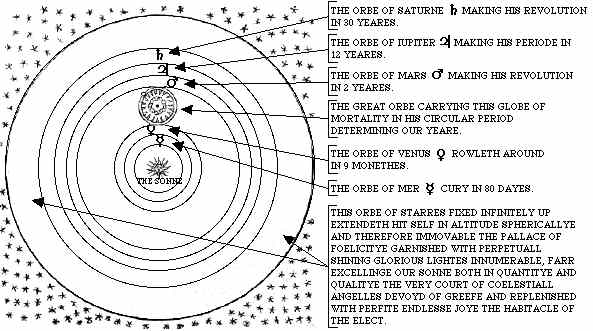Infinity, and the sun in the center
The first modern* astronomer to propose that the sun is in the centre of the planets (not a planet itself, revolving around the Earth) was Copernicus (a Latinizing of the Polish Kopérnic). He realized the greater mathematical logic of such a system, not to mention the accuracy*.
It was a great leap of imagination to think of the Earth spinning around something else, not in the centre of the spheres. Not surprisingly, religious leaders of the time were suspicious of the hypothesis, since it could be seen as irreligious to challenge the accepted view of the universe, since to do so was to challenge divine order; Copernicus' book, De revolutionibus orbium coelestium (published in the year of his death, 1543), was for a time forbidden reading (though it was dedicated to Pope Paul III, and though the mariners' charts derived from it continued to be used). Martin Luther was also opposed to the views of Copernicus.
Marlowe probably knew of the Copernican system, and Donne wrote of it, but there is no clear evidence*, internal or external to the plays, to tell us whether Shakespeare had heard of it.
The illustration
The original version of this diagram was published by Thomas Digges, an Englishman, in 1576. (Here the writing originally within the spheres is typed outside for reasons of clarity.) Digges went further than Copernicus in one important way: he suggested that there was no outer sphere for the fixed stars, but rather that the universe was infinite. The text of the outer sphere typically mixes scientific originality with religious fervour (here modern spelling is used):
This orb of stars fixed infinitely up extendeth it self in altitude spherically and therefore immovable; the palace of felicity garnished with perpetual shining glorious lights innumerable, far excelling our sun both in quantity and quality; the very court of celestial angels, devoid of grief and replenished with perfect endless joy; the habitacle [habitation] of the elect.
Notice that in the orb of the earth, where the moon's orbit is also indicated, Digges retains the traditional spheres of earth, water, air, and fire.
Footnotes
-
An old idea
Several earlier philosophers, following the Greek Heraclitus, had proposed both a heliocentric and infinite universe.
-
Building a better solar system
The Ptolemaic system worked reasonably well, but cumulative inaccuracies had led to obvious errors in predicting the movements of the planets, so useful to mariners. Of course, the Copernican system was itself very imperfect, since he assumed that the orbits of the planets were circular; see the next page.
-
Did Shakespeare know?
The fact that Donne knew, and that Shakespeare's earlier contemporary Marlowe almost certainly knew, suggests that the Copernican theory would have been common knowledge among writers of the time. Marlowe moved in circles that included James Heriot, a distinguished and original mathematician who wrote about the theory.
